Drumming circles have deep cultural roots that unite communities through rhythm, spirituality, and shared purpose. Ancient civilizations used drums to connect with the divine, reinforce social bonds, and support rituals. Different cultures express their identity through unique drums and rhythms, creating meaningful traditions. Today, modern circles blend tradition with innovation, continuing this powerful connection. To understand how these ancient practices still influence us, keep exploring their rich history and cultural significance.
Key Takeaways
- Drumming circles originate from ancient rituals that foster community bonding and spiritual communication across diverse cultures.
- They symbolize universal rhythms that connect individuals to cosmic and ancestral energies, strengthening cultural identity.
- Traditional drumming practices serve as tools for healing, emotional release, and collective storytelling within communities.
- Variations in drum construction and rhythms reflect unique cultural expressions and societal values worldwide.
- Modern drumming circles preserve and revitalize cultural traditions, promoting cross-cultural understanding and social cohesion today.
The Origins of Drumming in Ancient Civilizations
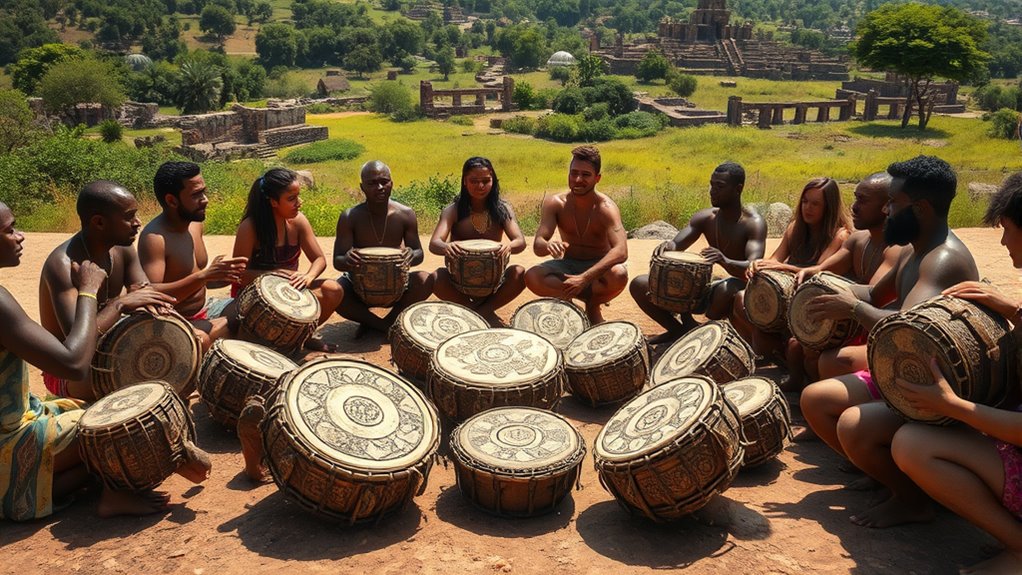
Ancient civilizations worldwide discovered that rhythm and percussion could unify communities and communicate with the divine. These early societies used drums to strengthen tribal identity, creating a sense of belonging and shared purpose. As musical evolution progressed, drums became central to rituals, celebrations, and storytelling, shaping cultural traditions. The consistent beat connected individuals, reinforcing social bonds and collective memory. Over time, different regions developed unique drumming styles that reflected their cultural values and spiritual beliefs. These early uses of drums not only solidified community ties but also marked important milestones in cultural identity. By embracing rhythm as a universal language, ancient peoples laid the groundwork for the diverse drumming practices we see today, emphasizing their essential role in societal cohesion and cultural expression.
Symbolism and Spiritual Significance of Drums
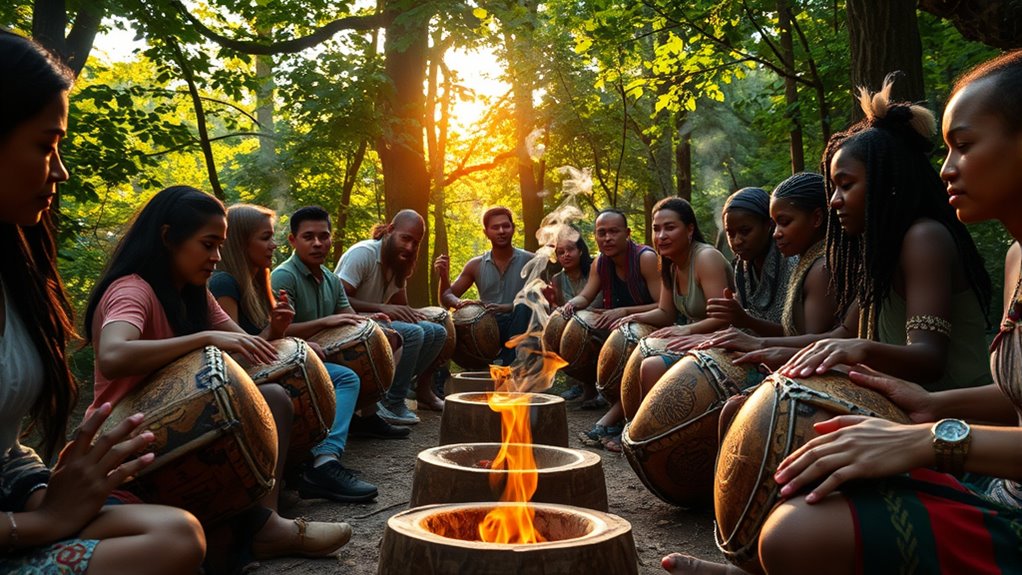
Drums have long held a profound symbolic and spiritual role across many cultures, serving as more than just musical instruments. They embody deep meanings, connecting you to ancestors, spirits, or divine forces. Understanding drum symbolism reveals that each beat can represent life cycles, spiritual journeys, or communal unity. The spiritual drum meaning often signifies communication with the divine or nature. Here are key aspects to contemplate:
- Drum rhythms symbolize the heartbeat of the universe, maintaining cosmic balance.
- They serve as conduits for spiritual communication, channeling messages from ancestors.
- Drums are tools for rituals that invoke protection, healing, or guidance.
- The act of drumming itself fosters spiritual awakening and inner harmony.
- Recognizing the spiritual significance of drums can deepen your connection to cultural traditions and personal growth.
Rituals and Community Bonding Through Rhythms
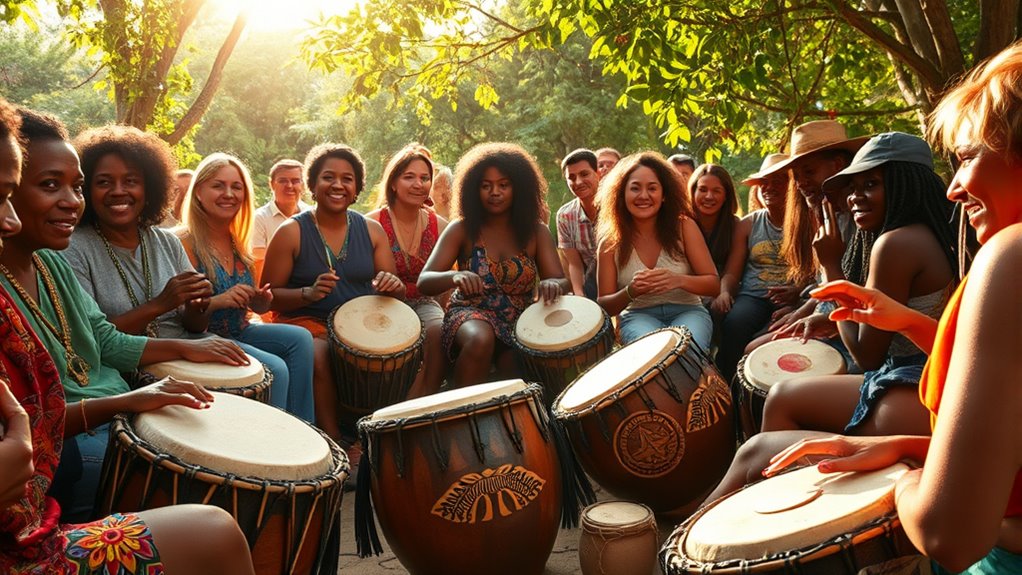
When people come together to create rhythmic patterns, they forge a powerful sense of unity and shared purpose that transcends individual differences. These rhythms often serve as the foundation for healing practices, helping participants release stress and emotional burdens. Through synchronized drumming, communities strengthen social cohesion, fostering trust and cooperation among members. Rituals built around these rhythms create a safe space where people feel connected, supported, and understood. As the beat unites everyone, it reinforces communal identity and shared values. Whether during ceremonies or informal gatherings, the collective experience of rhythm deepens bonds and nurtures a sense of belonging. In this way, drumming becomes more than just sound; it transforms into an essential tool for community building and emotional healing. Additionally, the practice of ethical hacking shares a similar approach by fostering collaboration and trust among security professionals to improve collective safety.
Variations of Drumming Traditions Around the World
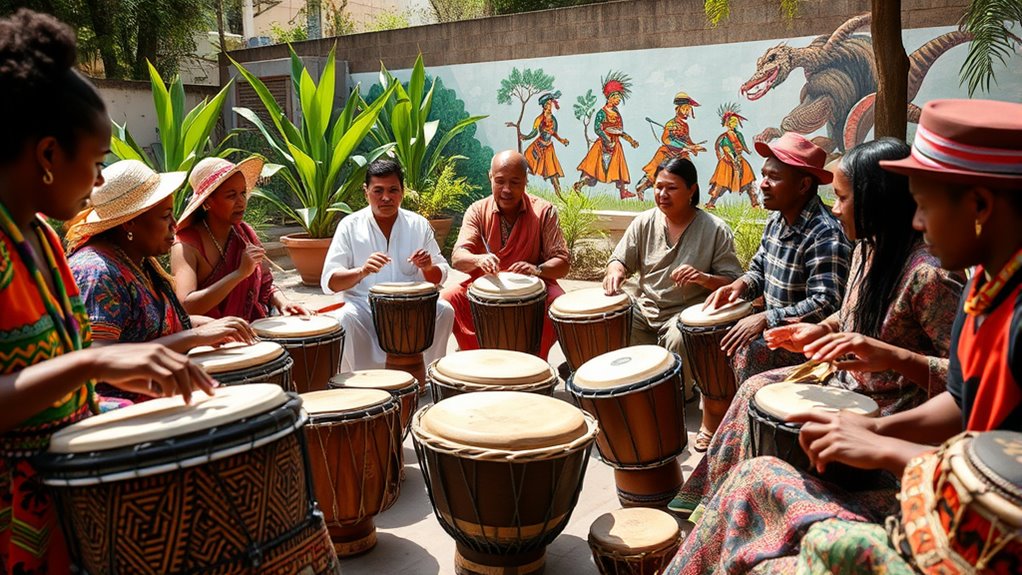
Have you ever wondered how different cultures express their unique identities through rhythm? Around the world, drumming traditions showcase diverse instrument construction and rhythmic patterns. For example, in West Africa, djembe drums are carved from single pieces of wood, producing complex polyrhythms. In Indonesia, gamelan ensembles utilize metallophones with intricate tuning systems, creating layered textures. The Native American powwow drums are often made from animal hides stretched over wooden frames, emphasizing communal beats. Finally, in Brazil, samba drums feature lightweight shells and syncopated rhythms that energize dance. These variations reflect cultural values and histories, showcasing how instrument construction influences sound and how rhythmic patterns serve as expressive tools. Exploring these differences deepens your understanding of the global tapestry of drumming traditions. Additionally, the cultural significance of drumming often plays a vital role in ceremonies and social cohesion within communities.
Modern Revivals and Global Influence of Drumming Circles
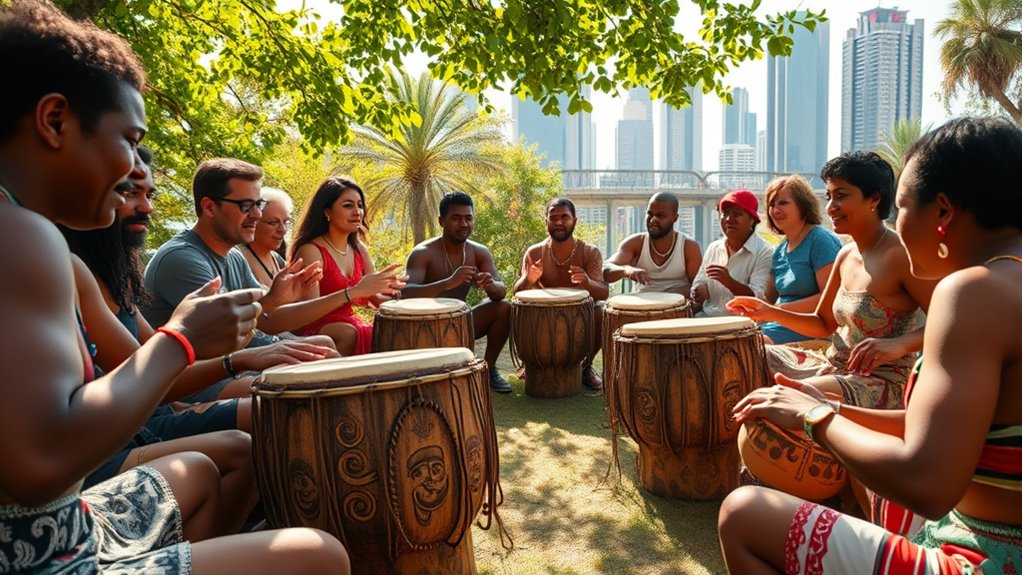
Ever wonder how drumming circles have experienced a resurgence in recent years? Today, they’re more than just communal activities; they’re tools for rhythm therapy and cultural preservation. Modern revivals attract people worldwide, blending traditional techniques with contemporary practices. These circles promote mental well-being, reduce stress, and foster connection, making rhythm therapy a popular approach. As global interest grows, communities embrace drumming as a way to honor their heritage while sharing it with others. This movement helps preserve cultural identities and encourages cross-cultural understanding. You might find yourself joining a local or international drumming circle, experiencing firsthand how these gatherings strengthen bonds and keep ancient traditions alive in a modern context. Additionally, the practice of cultural preservation through music and rhythm can be linked to global efforts to maintain and celebrate diverse heritages. The global influence of drumming circles keeps cultural roots vibrant and relevant today.
Frequently Asked Questions
How Do Drumming Circles Influence Personal Emotional Well-Being?
Drumming circles profoundly impact your emotional well-being by providing a space for emotional release and stress relief. As you participate, you actively engage in rhythmic patterns that help you express feelings, reducing anxiety and tension. The collective energy fosters a sense of connection, boosting your mood and resilience. This shared experience allows you to process emotions naturally, leaving you feeling more balanced, centered, and emotionally refreshed after every session.
What Role Do Gender and Social Hierarchies Play in Traditional Drumming Practices?
Imagine a river where gender roles and social hierarchy are the banks shaping the flow. In traditional drumming practices, these structures influence who leads the rhythm and who follows, reinforcing or challenging societal norms. You might find that certain gender roles dictate participation, and social hierarchy determines respect and authority within the circle. Recognizing these dynamics helps you understand how drumming both reflects and shapes cultural values surrounding gender and power.
Are There Specific Instruments Unique to Certain Cultures’ Drumming Traditions?
You’ll find that specific instruments hold cultural instrument distinctions, emphasizing traditional percussion uniqueness in various societies. These instruments reflect a culture’s history, environment, and spiritual beliefs, making them distinct to each tradition. For example, the djembe in West Africa or the taiko in Japan showcase traditional percussion uniqueness. Recognizing these differences enriches your understanding of how each culture’s music and rituals are deeply rooted in their unique musical instruments.
How Do Indigenous Communities Preserve Their Drumming Heritage Today?
Think of indigenous communities as guardians of a sacred flame, carefully passing it down through generations. Today, they preserve their drumming heritage through indigenous preservation efforts, cultural transmission, and community gatherings. These traditions stay alive by teaching younger members, recording rituals, and celebrating shared history. You can help support their ongoing efforts by respecting and learning about their unique musical practices, ensuring their vibrant rhythms continue to beat strong for generations to come.
What Are the Ethical Considerations in Adopting Cultural Drumming Practices?
When you adopt cultural drumming practices, you should prioritize respectful engagement and avoid cultural appropriation. This means understanding the significance of these traditions, seeking permission from community members, and giving proper credit. By doing so, you honor the cultural roots and support the community’s preservation efforts. Always approach with humility and a genuine desire to learn, ensuring your participation respects and sustains the cultural heritage.
Conclusion
By exploring the rich cultural roots of drumming, you realize it’s more than just beats—it’s a universal language that unites hearts across centuries and continents. These rhythms have the power to transform individuals and communities, creating bonds stronger than steel. When you join a drumming circle, you’re tapping into a timeless force that can ignite your spirit and connect you to something infinitely greater than yourself. It’s not just music; it’s the heartbeat of humanity itself.









